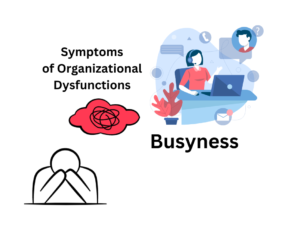 Busyness
Busyness
Our series on the symptoms of organizational dysfunctions continues with the second symptom, busyness. In our first two articles in this series, we introduced organizational dysfunctions and discussed complicated decision-making as their first symptom.
Busyness emerges when employees feel very busy and there is no time to make changes, improve, do anything different, evaluate performance, or strategize. Individuals within the organization focus more on getting the job done, and they are never done.
Busyness sounds like this in organizations:
“My job is never done.”
“I cannot leave my job to talk about strategy right now. I just have too much to do.”
“Working late and on weekends is part of my job. Otherwise, I will never catch up.”
“I am always playing catch-up. Eight hours is never enough.”
“I will not be able to attend that training; I am swamped.”
“I have been working so hard for the last two weeks, but I am not making progress.”
“You don’t understand our organization. We don’t really have time to meet because we have so much to do.”
The most deceptive aspect of busyness is that some leaders feel employees are committed when they are always busy. Busyness is not equal to hard work because busyness means more work and less outcome. People work really hard, but they have little to show for it. Progress will be slow, outputs will be far less than inputs, and learning will be difficult.
Busyness as a symptom of organizational dysfunction is a result of a lack of clear organizational vision and strategies, a lack of clear processes and procedures, and undefined expectations and outcomes. Many organizations have strategies, but there is no clear path from the strategy to operations. The “theoretical strategy” is different from the “strategy in use, as the real strategy is on the proverbial “shelf.” When leaders at different levels cannot operationalize the organizational strategy, they will struggle for direction. Their processes and procedures will conflict with the strategy thus reducing organizational effectiveness.
Busyness also emerges when expectations are unclear, and employees do not understand what success looks like. Clarity of expectations is critical to productivity, performance measurement, and accountability. When expectations are unclear, employees will not know what to do and how their performance will be measured. They also do not know how they are contributing to organizational outcomes. They feel that showing they are busy will show they are working hard, even if their output is low.
Busyness leads to burnout, stress, employee turnover, no sense of accomplishment, reduced organizational productivity, reduced efficiency, and increased expense. Many organizations recognize busyness, but they do not dig deeper to identify the real causes. Busyness is a cancer that destroys organizational outcomes, but it takes its root in deeper dysfunction that requires a deeper analysis to identify.
Ayodeji is a Senior Organizational Development Consultant at DeYoung Consulting Services, an organizational development and talent management firm Ayodeji specializes in leadership development, coaching, strategic planning, and change management. He holds a Doctor of Education in Leadership from Saint Mary’s University of Minnesota. Ayodeji is also the author of the book, Caring: The Soul of Leadership, which is available in paperback and e-book on Amazon.
